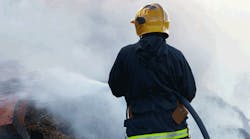On June 30, 19 firefighters rushed to battle a wildfire in Arizona and lost their lives in the process. The Prescott Fire Department in Prescott, Ariz., confirmed that 19 members of the department’s Granite Mountain Hotshots died while fighting the 2,000-acre Yarnell Hill fire that ignited June 29.
“This weekend, our state lost nineteen of its bravest firefighters in the wake of the Yarnell Fire, near Prescott,” said Arizona Governor Jan Brewer. “This fire is the deadliest wildfire in state history, and our nation’s deadliest in 80 years. The fire has also claimed the lives of more first responders than any single disaster since 9/11.”
Brewer has ordered that all state flags be flown at half-staff from sunrise, July 1, to sunset, July 3, as a tribute to the firefighters who lost their lives.
“This day will be eternally etched in Arizona’s memory,” Brewer said. “It will forever ring as one of our state’s darkest, most devastating days. It will forever remind us of the constant peril our firefighters selflessly face protecting us. We can never repay these 19 men and their families for their service and the ultimate sacrifice they made on our behalf. We can, however, offer them our deepest, eternal debt of gratitude.”
A Hero’s Job
According to the National Fire Protection Association (NFPA), the Yarnell Hill fatality count is the nation's third highest firefighter death toll for wildland fires. The 1910 Devil's Broom wildfire in Silverton, Idaho, killed 86 firefighters and the 1933 Griffith Park blaze in Los Angeles killed 29.
The American Industrial Hygiene Association (AIHA) released a statement expressing sadness for this tragic event – and stressed the importance of protecting workers who face hazardous jobs.
“Employers are responsible for the safety of their workers and must do everything they can to protect workers from the hazards associated with the response and recovery operations for wildfires,” AIHA stated, and pointed to OSHA resources on wildfire safety hazards including unstable structures, heavy equipment, hazardous materials and health hazards including heat stress and carbon monoxide.
“As details surrounding this tragedy unfold, I ask that you continue to keep these men, their families and all of our first responders in your prayers,” Brewer said. “Remember that, for them, no task is ever without threat or danger. That they go to work daily with that risk in-mind makes them heroic.”
NFPA data reveals that firefighter fatalities have been declining in recent years. NFPA recently released its annual Firefighter Fatality Report that showed there were 64 firefighter on-duty deaths in 2012, the second lowest in 35 years. For the past 4 years, the annual total has been well below 100, dropping the annual average over the past 10 years to 88 deaths.
NFPA offers additional information about firefighter fatalities; a list of deadliest incidents that resulted in the deaths of eight or more firefighters; and a special focus on wildland fires.

